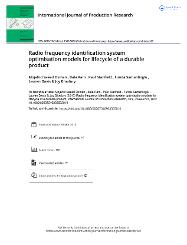| dc.contributor.author | Osman, Mojahid Saeed | |
| dc.contributor.author | Ram, Bala | |
| dc.contributor.author | Stanfield, Paul | |
| dc.contributor.author | Samanlıoğlu, Funda | |
| dc.contributor.author | Davis, Lauren B. | |
| dc.contributor.author | Bhadury, Joy | |
| dc.date.accessioned | 2019-06-27T08:05:24Z | |
| dc.date.available | 2019-06-27T08:05:24Z | |
| dc.date.issued | 2010 | |
| dc.identifier.issn | 0020-7543 | en_US |
| dc.identifier.uri | https://hdl.handle.net/20.500.12469/1069 | |
| dc.identifier.uri | https://doi.org/10.1080/00207540903565014 | |
| dc.description.abstract | We address the implementation of radio frequency identification (RFID) technology to support and manage durable products over their entire lifecycle with a focus on optimising the RFID tagging system. We develop general models that optimise the placement of RFID tags on an end product and its components the allocation of the data on tags and the selection of RFID tags and their configuration. The primary criteria for optimisation are to maximise the value of RFID data and to minimise the total cost of the RFID tag system. The total cost of RFID tags comprises costs associated with memory capacity tag type software acquisition and maintenance and number of tags used | en_US] |
| dc.description.abstract | the total value for a piece of data is determined by the data usage frequency and the fixed and variable value of data per use across the product lifecycle. The tag placement and data allocation model involves making a decision about these two different objectives - cost and value which we develop in the form of a multi-objective optimisation problem. The tag selection model aids in the proper selection of RFID tags and their configuration for individual components for a given end product. Given a durable product's characteristics along with its bill-of-materials a system of RFID tags can efficiently be determined for the product and its components to help manage and support its lifecycle. | en_US] |
| dc.language.iso | eng | en_US |
| dc.publisher | Taylor & Francis Ltd | en_US |
| dc.rights | info:eu-repo/semantics/openAccess | en_US |
| dc.subject | RFID | en_US |
| dc.subject | Optimisation | en_US |
| dc.subject | Value of information | en_US |
| dc.subject | Lifecycle management | en_US |
| dc.subject | Maintenance | en_US |
| dc.title | Radio frequency identification system optimisation models for lifecycle of a durable product | en_US |
| dc.type | article | en_US |
| dc.identifier.startpage | 2699 | en_US |
| dc.identifier.endpage | 2721 | |
| dc.relation.journal | International Journal Of Production Research | en_US |
| dc.identifier.issue | 9 | |
| dc.identifier.volume | 48 | en_US |
| dc.department | Fakülteler, Mühendislik ve Doğa Bilimleri Fakültesi, Endüstri Mühendisliği Bölümü | en_US |
| dc.identifier.wos | WOS:000276470400011 | en_US |
| dc.identifier.doi | 10.1080/00207540903565014 | en_US |
| dc.identifier.scopus | 2-s2.0-77951096896 | en_US |
| dc.institutionauthor | Samanlıoğlu, Funda | en_US |
| dc.relation.publicationcategory | Makale - Uluslararası Hakemli Dergi - Kurum Öğretim Elemanı | en_US |
















